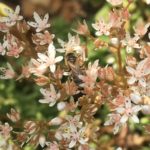
by Amy Nyman | Mar 14, 2018 | Ecological Gardens, native bee habitat, Native bees, support wildlife, supporting wildlife, Wildlife Habitat
Bees are our friends, despite the occasional painful bee sting and medical concern of allergies to bee stings. Bees pollinate the plants that produce our food and, therefore, are required for our survival. There are many more species than just the honeybee, which is a species introduced to North America – native bees make up the greatest portion of our bee population.
We need to understand bees in order to appreciate them and support their survival. Most of our native bees are not aggressive and many are solitary dwellers – they do not live in colonies like the honeybee. For some in-depth information on specific bee species and their preferred habitats and food sources, read this great bulletin from the University of Maine or this article from the National Wildlife Federation.
Despite the fact that most bees are not aggressive, bees being near to our living spaces can sometime cause concern for some people. We will never completely remove bees from our outdoor spaces, nor should we want to. But if you need to keep bees somewhat distant from your living or play spaces (due to an allergy to bee stings or to reduce fearful encounters), there are preventive techniques and habitat modifications that you can adopt, such as:
- Remove bee food sources near your living areas.
- Keep garbage cans tightly closed.
- Remove nests from under eaves and from tree branches that are near doorways or sitting areas.
- Repair or cover holes in any outdoor structures – any unsealed area should be sealed with caulk, wood, or flashing.
- Inspect sensitive areas monthly during the active bee season to monitor for new nests.
-

-

-

-

-
NE native bees on sedum.
-

-
Native Bees Poster – Image from the National Wildlife Federation.

by Amy Nyman | Feb 13, 2016 | bird habitat, creating bird habitat, Ecological Gardens, Feed the birds, native plant for birds, native plants for birds, Plants, support wildlife, supporting wildlife, Sustainable Gardening, Wildlife Habitat
Below are some helpful online resources showing what native plant species benefit what birds, mostly as food sources, but some as cover or nesting material. Adding a variety of these plants to your landscape can support bird ecology with cover protection, nesting material, fruit and seeds for multiple seasons, and increasing the insect population that many birds feed upon. These plants also support pollinators, such as bees and butterflies, and other beneficial insects. Native plants can easily fit into a traditional landscape while adding beauty, drought resistance, and increased biodiversity for a variety of ecological benefits.
Native Plants for Breeding Birds by Credit Valley Conservation is a beautiful visual reference that includes foraging guilds and nesting.
Gardening for Wildlife Plant List.pdf by Loudoun Wildlife Conservancy. This list includes wildflowers, shrubs, and trees. The document also provides a great list of books used to develop their plant list and which provide even more detailed information.
Audubon now has a Native Plant Database that allows you to enter your zip code to search the native plants in your area and includes information about which bird species those plants support – this one is pictorial and lists plants alphabetically. Or you can use the Full Results page that provides the information as text. Both tabs allow you to search and filter by plant type, plant resources (think fruit, butterflies, seed) and attractors of specific bird families (hummingbirds, finches, warblers, etc.).







